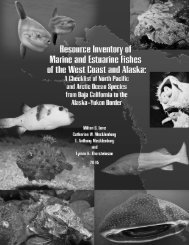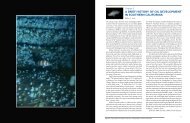Reproductive Ecology and Body Burden of Resident ... - The Love Lab
Reproductive Ecology and Body Burden of Resident ... - The Love Lab
Reproductive Ecology and Body Burden of Resident ... - The Love Lab
You also want an ePaper? Increase the reach of your titles
YUMPU automatically turns print PDFs into web optimized ePapers that Google loves.
variation in elemental concentrations. This assumption is based on general observations by several investigators<br />
that concentrations <strong>of</strong> at least some elements can occasionally vary with fish age (or TL <strong>and</strong> weight,<br />
which are proxies <strong>of</strong> age; e.g., Phillips <strong>and</strong> Russo 1978, Mance 1987). Additionally, we assumed that elemental<br />
concentrations could vary locally among each grouping <strong>of</strong> oil platform <strong>and</strong> two nearby natural areas<br />
(“Group” variable nested in HabType; see Table 1 for Group designations). <strong>The</strong>refore, our strategy was to<br />
use analysis <strong>of</strong> covariance (ANCOVA) with mixed effects, with HabType <strong>and</strong> TL (the continuous covariate)<br />
as fixed effects, <strong>and</strong> Group <strong>and</strong> Group*TL interaction as r<strong>and</strong>om effects (Littell et al. 1996). We estimated<br />
all effects using restricted maximum likelihood as the fitting algorithm, which yields unbiased estimates<br />
<strong>of</strong> covariance <strong>and</strong> variance, <strong>and</strong> we tested these effects using F-tests based on Satterthwaite’s formula for<br />
degrees <strong>of</strong> freedom (Littell et al. 1996). Although we assumed that any <strong>of</strong> these effects or interactions could<br />
be present, the occurrence <strong>of</strong> a TL effect complicated our interpretations <strong>of</strong> elemental concentrations at oil<br />
platforms <strong>and</strong> natural areas. Thus, we retained the TL effect only if it was significant at the 0.05 level. We<br />
first determined if the interaction term was significant, <strong>and</strong> removed it from the ANCOVA model if significance<br />
was not achieved. We then tested the TL effect for significance, <strong>and</strong> removed it if not significant (at<br />
which point, the ANCOVA simplifies to an ANOVA with r<strong>and</strong>om effects). Least squares means <strong>and</strong> 95%<br />
confidence intervals were also computed for each HabType regardless <strong>of</strong> whether a statistically significant<br />
difference was detected.<br />
We interpreted results from the linear mixed models analysis <strong>of</strong> elemental concentrations for each fish<br />
species as follows: a significant HabType*TL interaction indicated that the effect <strong>of</strong> HabType on elemental<br />
concentration varied with fish TL <strong>and</strong>, conversely, the effect <strong>of</strong> fish TL varied between oil platforms <strong>and</strong><br />
natural areas. If HabType*TL interaction was significant, we calculated separate mean concentrations <strong>of</strong> the<br />
element at each HabType for small fish <strong>and</strong> large fish (the selected TLs representing small <strong>and</strong> large fish were<br />
chosen from the ranges <strong>of</strong> minimum TLs <strong>and</strong> maximum TLs common to both HabTypes). If HabType*TL<br />
interaction was not significant but TL was significant, we omitted effects from the interaction <strong>and</strong> calculated<br />
the mean concentration <strong>of</strong> the element within each HabType for fish <strong>of</strong> average TL. If both HabType*TL<br />
interaction <strong>and</strong> TL effects were not significant, we omitted both effects, thus reducing the model to an<br />
ANOVA that estimated only the HabType effect. In this instance, the mean concentration <strong>of</strong> an element at<br />
each HabType applied to all fish regardless <strong>of</strong> TL.<br />
Additional statistical summaries <strong>of</strong> data including computation <strong>of</strong> Pearson product-moment correlation<br />
analysis. Moreover, to ensure normality, raw data were routinely subjected to st<strong>and</strong>ard transformations<br />
(e.g., angular transformation for moisture percentage; logarithmic transformation for TL, weight, <strong>and</strong> concentrations<br />
<strong>of</strong> various elements).<br />
Results <strong>and</strong> Discussion<br />
A total <strong>of</strong> 196 whole-body fish samples (18 kelp bass, 80 kelp rockfish, <strong>and</strong> 98 Pacific s<strong>and</strong>dab) was analyzed<br />
for 63 elements during this study (Table 2). Geometric mean TLs <strong>and</strong> weights <strong>of</strong> fishes were as follows<br />
(95% confidence limits in parentheses): kelp bass, 34.3 cm (32.9-35.8 cm), 533 g (466-610 g); kelp rockfish,<br />
25.1 cm (24.2-26.1 cm), 264 g (234-299 g); <strong>and</strong> Pacific s<strong>and</strong>dab, 19.4 cm (18.6-20.2 cm), 82 g (72-94 g).<br />
Although mean TLs <strong>and</strong> weights did not vary over sampling sites for kelp bass, they varied significantly for<br />
kelp rockfish <strong>and</strong> Pacific s<strong>and</strong>dab (Table 3).<br />
Moisture content averaged 67.9% (95% confidence interval, 66.9-68.9%) in kelp bass, 74.2% (95%<br />
confidence interval, 73.0-75.4%) in kelp rockfish, <strong>and</strong> 80.1% (95% confidence interval, 79.7-80.4%) in Pacific<br />
s<strong>and</strong>dab (Table 2). Although moisture content did not vary among sampling sites for kelp bass, significant<br />
differences were detected for kelp rockfish <strong>and</strong> Pacific s<strong>and</strong>dab (Table 3). With one exception, moisture<br />
content was not significantly correlated with TL or weight in all three species (data not shown). Moisture<br />
9




